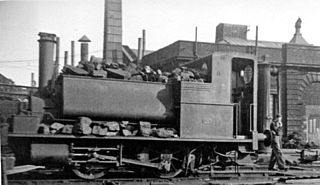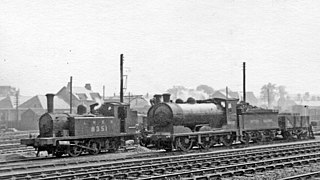Related Research Articles

The Great Eastern Railway (GER) Class Y14 is a class of 0-6-0 steam locomotive. The LNER classified them J15.

The NBR C Class is a class of 0-6-0 steam locomotive designed by Matthew Holmes for freight work on the North British Railway. They were introduced in 1888 and had inside cylinders and Stephenson valve gear. A total of 168 locomotives was built, of which 123 came into British Railways ownership at nationalisation in 1948. This was the last class of steam engine in service in Scotland.

The NBR K class is a class of 4-4-0 steam locomotive of the North British Railway. The first batch was designed by Matthew Holmes in 1902 and had 6-foot-6-inch (1.981 m) driving wheels for express passenger work. Three more batches were designed by William P. Reid with 6-foot-0-inch (1.829 m) driving wheels for mixed traffic work. This included perishable goods, such as fish from Mallaig and Aberdeen. They had inside cylinders and Stephenson valve gear. The D34 locomotives, commonly known as Glen Class, were built with superheaters. The LNER later fitted superheaters to all D26, D32, and D33 engines as well. All engines of the K class are sometimes known as Glen Class, although the designation is strictly reserved to the fourth (D34) batch.

The North British Railway (NBR) G Class is a class of 0-4-0ST steam locomotive designed for shunting. Some locomotives were equipped with small wooden tenders to carry extra coal. They were introduced in 1882 and thirty-eight entered service on the NBR between 1882 and 1899. Like most 0-4-0 tanks of the period it has outside cylinders and inside slide valves driven by Stephenson valve gear. The rival Caledonian Railway had the same number (38) of identical locomotives in service. The nickname "Pug" was used on the NBR.

Dugald Drummond was a Scottish steam locomotive engineer. He had a career with the North British Railway, LB&SCR, Caledonian Railway and London and South Western Railway. He was the older brother of the engineer Peter Drummond, who often followed Dugald's ideas in his own work.

The Great Northern Railway (GNR) Class O2 was a class of three-cylinder 2-8-0 steam locomotives designed by Nigel Gresley for freight work and built by the GNR from 1921. Further examples were built by the London and North Eastern Railway (LNER) from 1924.
William Paton Reid was apprenticed to the Cowlairs railway works of the North British Railway in 1879 and was Locomotive Superintendent from 1903-1919. He was awarded a CBE in 1920. He was born, and died, in Glasgow, Scotland.

The Caledonian Railway 264 and 611 classes were 0-4-0 saddle tank locomotives designed by Dugald Drummond and built by Neilson and Company in 1885. Later examples were built at St. Rollox railway works under the direction of John F. McIntosh in 1895, 1900, 1902 and 1908.

The GER Class 209 was a class of 0-4-0 saddle tank steam locomotives of the Great Eastern Railway. These locomotives were similar to the NBR G Class but had flat-topped, instead of round-topped, tanks. A total of eight were built – four by Neilson and Company in 1874 and four more by the GER's Stratford Works between 1897 and 1903.
Walter Chalmers was a Scottish engineer. He followed his father into the North British Railway, starting as an apprentice at Cowlairs railway works. In 1904 he became Chief Draughtsman and, from 1920 to 1922, he was Chief Mechanical Engineer.
The NBR Class M was a class of 4-4-0 steam locomotive of the North British Railway. The class was created during the tenures of William P. Reid and Walter Chalmers by rebuilding three earlier types, the "574", "633", and "729", which had all been designed by Matthew Holmes, and shared many features in common. A total of 48 were produced.

The NBR J Class , commonly known as the Scott class, were a class of 4-4-0 steam tender locomotives designed by William P. Reid for the North British Railway. They passed to the London and North Eastern Railway at the grouping in 1923. Forty-three were built, of which thirty-five survived into British Railways ownership in 1948.

The NBR S Class is a class of 0-6-0 steam locomotive designed by William Paton Reid for freight work on the North British Railway. The engines were initially designated as B class, being a development of the standard B class locomotives designed by Reid some eight years previously, and represented the culmination of a long evolution on the NBR of powerful 0-6-0 freight engines. The new locomotives were introduced in 1914 and had superheaters, inside cylinders and piston valves operated by Stephenson valve gear.

The NBR D Class was a class of 0-6-0 tank locomotives designed by Matthew Holmes for short distance freight, station pilot, and heavy shunting duties on the North British Railway.

The NBR A Class (London and North Eastern Railway Classes N14 and N15 were the standard 0-6-2 tank locomotives designed by William P. Reid for freight duties on the North British Railway. The LNER regarded the original locomotives as two separate classes. The final batch of locomotives was on order at the time of the grouping in 1923.
The NBR 141 Class consisted of two steam 2-4-0 locomotives built by the North British Railway (NBR) in 1869. They were the direct antecedents of the NBR 224 Class 4-4-0.

The North British Atlantic, later known as NBR Class H, and then as LNER Class C11 was a class of 4-4-2 steam locomotive of the North British Railway. The class was designed by William P. Reid, Locomotive Superintendent of the NBR, and entered service under his direction. They were the heaviest, longest, and most powerful locomotives ever employed on the North British Railway.

The NBR Class N was a class of 4-4-0 steam locomotive of the North British Railway. The class was designed by Matthew Holmes and later rebuilt by Holmes's successor, Reid. A total of 12 were produced.
The Glasgow and South Western Railway (G&SWR) 279 Class was a class of 0-6-0 steam locomotive designed by Peter Drummond, of which 15 were built in 1913 by the North British Locomotive Company at its Queens Park works. Originally built as the 279 class, as a result of renumbering they became known as the 71 Class in 1919, before passing to the London Midland and Scottish Railway (LMS) on its formation in 1923, where they were given power classification 4F.

The NBR F Class was a class of 0-6-0 tank locomotives, designed by William P. Reid on the North British Railway. They were used for dockyard shunting duties.
References
- ↑ "The Drummond J34 (NBR Class D) 0-6-0 Locomotives". The London & North Eastern Railway Encyclopedia. Retrieved 21 March 2016.
- ↑ "The Holmes J33 (NBR Class D) 0-6-0 Locomotives". The London & North Eastern Railway Encyclopedia. Retrieved 21 March 2016.
- ↑ See SteamIndex, NBR loco page, section headed Drummond designs.
- 1 2 Thomas, John (1975). The North British Railway. Volume 2 (1879-1922). David and Charles. ISBN 0-7153-6699-8.
- ↑ Railways Archive accident record.